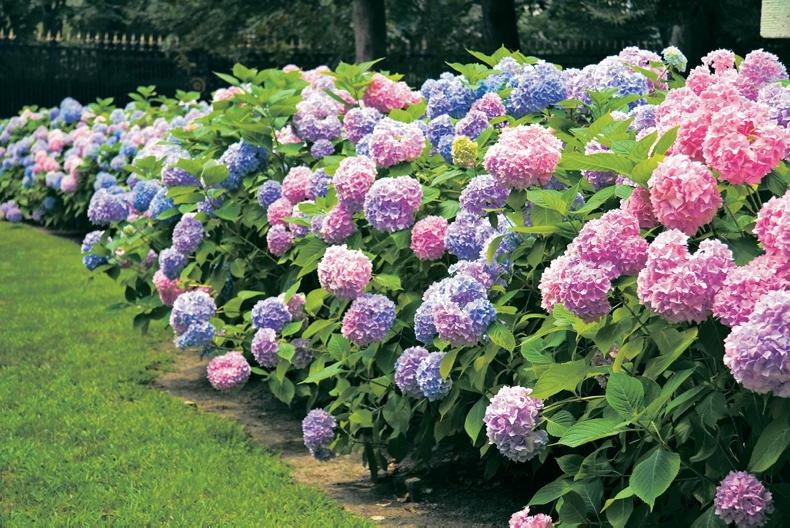Although related to common garden weeds, such as knotweed and redshank, the ornamental species make fine decorative plants for garden use, and they have thrived in the long spells of damp weather this year.
Persicaria campanulata is native to the Himalayan region of China and grows to about one metre tall and wide. It overwinters as quite tight rosettes at soil level and from spring and early summer begins to grow very quickly with tall fleshy stems and heart-shaped pointed leaves.
The stems carry the flowers in delicate branching flower sprays. The tiny individual flowers are pale pink and like little bells in shape. This is a great plant for a country garden. It is very robust, loves rich, moist soil and will take a considerable degree of shade. Flowering starts in mid-summer and continues until the frosts finish it off.
Burst of colour
Another big vigorous grower is the lovely Persicaria amplexicaulis. This forms a mound of foliage, long and tongue-like. The flowers are carried from mid-summer onwards. Unlike the sprays of flowers carried by the species mentioned, the flowers of this species are carried in slender flower spikes that are held clear of the foliage. The flowers are red or pink and there are almost white forms.
One of the most beautiful is ‘Firetail’, a bright red-crimson colour and slender, the flowers carried in profusion on slender long, branching stems, giving it a lively airy effect.
Bistort, Persicaria bistorta, is not as tall as those mentioned and it is a heavier plant with more substantial flowers and stems. It loves moist ground and looks well by a stream-edge, or in a bog-garden.
Like its two larger relatives, this plant is vigorous and produces a leafy top that competes well with weeds. The pale pink flowers are carried in short, relatively heavy spikes and are produced from early summer to autumn, often in flushes. All three of the kinds mentioned are much better grown in large drifts, rather than as single plants.
Apart from the large fleshy-stemmed species, there are several small wiry-stemmed species that are worth having. These are species adapted for different circumstances, growing in rocky mountain meadows and scrub areas. They are great plants for a large rock garden or for trailing over low walls or for the base of a wall.
The best-known is Persicaria affinis, which makes a broad spreading mat of green leaves from which arise elegant pink flower spikes on short slender stems. The flowers are carried well clear of the mat of foliage, flowering from mid-summer well into autumn.
Pink ladies
The flowers are pink and late in the growing season, the flowers turn brown, followed by the leaves and can remain very decorative over the winter season. ‘Superba’ has pink flowers that turn red. ‘Dimity’ has light pink flowers and its leaves turn red in autumn before withering to brown. ‘Darjeeling Red’ is a vigorous form that has pink flowers turning red.
Smaller again is Persicaria vacciniifolia which makes a flat carpet of small leaves, much more compact than Persicaria affinis. It flowers in late summer and well into autumn, producing upright spikes of small pink flowers. The flowers look remarkably like those of heather. This species can be grown in a rock garden and looks great creeping over the low wall of a raised bed or on the surface at the base of a wall. These plants are easy to propagate by division.
Fruit, vegetables and herbs: Remove old vegetables as soon as they are finished and do not allow weeds to grow and go to seed.
Flowers: Planting of spring bulbs should be completed as soon as possible. Bedding flowers can be replaced now with spring bedding and bulbs. Begin dividing perennial flowers, except grasses which prefer to be split in spring.
Lawn: Lawns are in great shape after a damp summer and warm autumn. Apply lawn mosskiller now if necessary, particularly in shaded areas. Continue mowing and use an autumn lawn fertiliser, if the grass is of poor colour.
Tree, shrubs and roses: Plant evergreen trees and shrubs of all kinds, either from
pots or as root-balled plants.
Q&A: Should I prune withering hydrangeas?

Removing withering flowers is optional. \iStock
I have withering flowers on my hydrangeas and not sure if I should remove them or leave them. What can you advise? - A Murphy, Blessington, Co Wicklow
Some advisers offer the opinion that they should be left in place until spring because they offer a degree of frost protection. While the withering flowers now changing colour to brown, do give some protection against frost later in winter, it is not enough to make a huge difference if these are removed.
Largely, it comes down to a question of choice, some people consider the withered flower heads to be unsightly and others regard them as part of the natural cycle of growth, so there is no wrong answer really. Take your pick!
Although related to common garden weeds, such as knotweed and redshank, the ornamental species make fine decorative plants for garden use, and they have thrived in the long spells of damp weather this year.
Persicaria campanulata is native to the Himalayan region of China and grows to about one metre tall and wide. It overwinters as quite tight rosettes at soil level and from spring and early summer begins to grow very quickly with tall fleshy stems and heart-shaped pointed leaves.
The stems carry the flowers in delicate branching flower sprays. The tiny individual flowers are pale pink and like little bells in shape. This is a great plant for a country garden. It is very robust, loves rich, moist soil and will take a considerable degree of shade. Flowering starts in mid-summer and continues until the frosts finish it off.
Burst of colour
Another big vigorous grower is the lovely Persicaria amplexicaulis. This forms a mound of foliage, long and tongue-like. The flowers are carried from mid-summer onwards. Unlike the sprays of flowers carried by the species mentioned, the flowers of this species are carried in slender flower spikes that are held clear of the foliage. The flowers are red or pink and there are almost white forms.
One of the most beautiful is ‘Firetail’, a bright red-crimson colour and slender, the flowers carried in profusion on slender long, branching stems, giving it a lively airy effect.
Bistort, Persicaria bistorta, is not as tall as those mentioned and it is a heavier plant with more substantial flowers and stems. It loves moist ground and looks well by a stream-edge, or in a bog-garden.
Like its two larger relatives, this plant is vigorous and produces a leafy top that competes well with weeds. The pale pink flowers are carried in short, relatively heavy spikes and are produced from early summer to autumn, often in flushes. All three of the kinds mentioned are much better grown in large drifts, rather than as single plants.
Apart from the large fleshy-stemmed species, there are several small wiry-stemmed species that are worth having. These are species adapted for different circumstances, growing in rocky mountain meadows and scrub areas. They are great plants for a large rock garden or for trailing over low walls or for the base of a wall.
The best-known is Persicaria affinis, which makes a broad spreading mat of green leaves from which arise elegant pink flower spikes on short slender stems. The flowers are carried well clear of the mat of foliage, flowering from mid-summer well into autumn.
Pink ladies
The flowers are pink and late in the growing season, the flowers turn brown, followed by the leaves and can remain very decorative over the winter season. ‘Superba’ has pink flowers that turn red. ‘Dimity’ has light pink flowers and its leaves turn red in autumn before withering to brown. ‘Darjeeling Red’ is a vigorous form that has pink flowers turning red.
Smaller again is Persicaria vacciniifolia which makes a flat carpet of small leaves, much more compact than Persicaria affinis. It flowers in late summer and well into autumn, producing upright spikes of small pink flowers. The flowers look remarkably like those of heather. This species can be grown in a rock garden and looks great creeping over the low wall of a raised bed or on the surface at the base of a wall. These plants are easy to propagate by division.
Fruit, vegetables and herbs: Remove old vegetables as soon as they are finished and do not allow weeds to grow and go to seed.
Flowers: Planting of spring bulbs should be completed as soon as possible. Bedding flowers can be replaced now with spring bedding and bulbs. Begin dividing perennial flowers, except grasses which prefer to be split in spring.
Lawn: Lawns are in great shape after a damp summer and warm autumn. Apply lawn mosskiller now if necessary, particularly in shaded areas. Continue mowing and use an autumn lawn fertiliser, if the grass is of poor colour.
Tree, shrubs and roses: Plant evergreen trees and shrubs of all kinds, either from
pots or as root-balled plants.
Q&A: Should I prune withering hydrangeas?

Removing withering flowers is optional. \iStock
I have withering flowers on my hydrangeas and not sure if I should remove them or leave them. What can you advise? - A Murphy, Blessington, Co Wicklow
Some advisers offer the opinion that they should be left in place until spring because they offer a degree of frost protection. While the withering flowers now changing colour to brown, do give some protection against frost later in winter, it is not enough to make a huge difference if these are removed.
Largely, it comes down to a question of choice, some people consider the withered flower heads to be unsightly and others regard them as part of the natural cycle of growth, so there is no wrong answer really. Take your pick!










SHARING OPTIONS